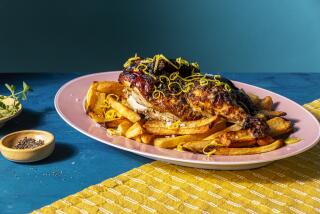Culture Club : Tote That Yogurt
- Share via
Yogurt formulas that tell you to ferment the mixture in a gas oven, using the pilot light for warmth, drive me crazy. What if you have an electric stove, as I do?
Two factors made me decide to try anyway. First, I’ve been traveling in yogurt-conscious countries such as India and Sri Lanka. Yogurt in those places is the richest, creamiest stuff imaginable. It’s wonderful topped with jaggery --the dark-brown palm sugar used in Sri Lanka. It’s delicious in shrikhand , a saffron-flavored yogurt pudding that I ate repeatedly in a Gujarati restaurant in Bombay. And it’s wonderful at home, with Piru Canyon honey and fresh strawberries.
When I decided to make my own yogurt, I turned for technical advice and yogurt starter to Sofi Konstantinidis of the restaurant Sofi Estiatorion on West 3rd Street in Los Angeles. Konstantinidis brought her starter from Greece and makes superlative, mellow yogurt. She prefers unpasteurized goat or sheep’s milk. I started out with supermarket low-fat milk.
My first batch was terrible. The yogurt was thin, almost liquid; the flavor was too tart, and the method (my idea, not Konstantinidis’) was cumbersome and possibly hazardous. I wrapped the bowl of milk and starter in a blanket and stuffed it into an oven that had been warmed and turned off. Too much heat and/or inconsistent heat guarantee disaster.
The second batch, covered with plastic wrap and foil and buried in blankets in an airless room, was encouraging. Then the pilot light in my head went on, and out popped the solution. The method is simple, reliable and so easy I now make yogurt every week.
The only special equipment needed is an instant-read thermometer, which every cook should have anyway for roasts and Thanksgiving turkeys. You also need an insulated picnic tote. I use a thick nylon carrying case that zips shut.
Here is the procedure: Following Konstantinidis’ advice, I boil the milk until it rises in the saucepan, then set it aside to cool to the proper temperature for adding the starter. (The starter is a few spoonfuls of yogurt, obtained from a yogurt-making friend, an active-culture supermarket yogurt or a batch you’ve made.) Konstantinidis judges the temperature of the milk with her finger. I use a thermometer.
Greeks set yogurt in clay pots, as do Sri Lankans. That keeps the yogurt from becoming watery, Konstantinidis says. So does using very rich milk. I make do with a crockery bowl that I bought in a thrift shop. I warm the bowl with very hot tap water, and I let the starter stand at room temperature so it won’t be icy cold.
When the boiled milk is “warm but not hot,” as Konstantinidis says, I stir a little into the starter, turn this into the crockery bowl and add the remainder of the milk. Konstantinidis, who has a gas range, covers her bowl with a towel, then a lid and places it in the oven. I cover the bowl with plastic wrap, then towels, then plastic bubble wrap, and zip it into the nylon tote. The bubble wrap is probably not essential, but it was stored in the tote, so I add it for good measure.
The tote containing the fermenting milk should stand undisturbed in as warm a place as you can find. Once I placed it by a glass door with the sun streaming in. Another time, it sat overnight on a kitchen chair. After eight or nine hours, the yogurt will be firm and the bowl still warm.
The following recipe produces full-flavored, creamy yogurt, which is what I like. I’ve also made yogurt with low-fat milk, sneaking in a couple of tablespoons of whipping cream. That turned out well too. Adding nonfat dry milk increases the nutritional value.
Store the yogurt, tightly covered, in the refrigerator. Some liquid, the whey, will separate as it stands, but you can drain that off. You’ll notice that commercial yogurt is firmer than homemade yogurt--but read the carton labels--you’ll find it contains thickening ingredients such as pectin, tapioca or gelatin. To obtain thick consistency, Konstantinidis wraps yogurt in cheesecloth and lets it hang over a bowl--this drains the whey from the yogurt, something that’s always been done in yogurt-making cuisines. Drained yogurt made from full-cream milk will wind up thick enough to cut with a knife.
If you need starter, Konstantinidis recommends buying Bulgarian-style whole-milk yogurt. Making your own yogurt allows you to vary the quantity and richness as needed or to suit your nutritional requirements.
You’ll find it as handy as sour cream and mayonnaise. So far, I’ve used yogurt in salad dressings, combined it with fruit for breakfast, mixed it with cucumber as a relish and drizzled yogurt with Greek thyme honey for dessert. Konstantinidis uses it in almost everything, including soups, salads, a seasoning mixture for lamb and a cake.
Greeks eat yogurt for breakfast with fresh figs or fruit preserves and crusty bread. And they have some just before going to bed. It’s as soothing as a sleeping pill.
STOVELESS HOMEMADE YOGURT 2 2/3 cups whole milk 1/3 cup whipping cream 1/3 cup instant nonfat dry milk powder 1/4 cup yogurt for starter
Combine milk and cream in saucepan. Heat until boils and rises in pan. Set aside to cool to 120 degrees.
Stir in dry milk thoroughly. Cool to 115 degrees. Place yogurt for starter in warmed 1-quart crockery bowl. Stir in some of milk mixture until blended. Add all of milk mixture and stir lightly. Cover bowl with plastic wrap. Wrap in towels and place in insulated picnic tote.
Close securely. Let stand undisturbed in warm place without drafts 8 to 10 hours. When yogurt is set, remove from picnic tote and store, tightly covered, in refrigerator. Makes about 3 1/4 cups.
BACKGROUND
If you think you’re seeing more frozen yogurt around, it’s because you are. According to the Haagen-Dazs company, frozen yogurt is the fastest-growing segment in the “frozen dessert” category; in 1992, sales jumped 14%. During that time, sales in the “super-premium frozen yogurt” category grew an astonishing 29%.
More to Read
Eat your way across L.A.
Get our weekly Tasting Notes newsletter for reviews, news and more.
You may occasionally receive promotional content from the Los Angeles Times.






